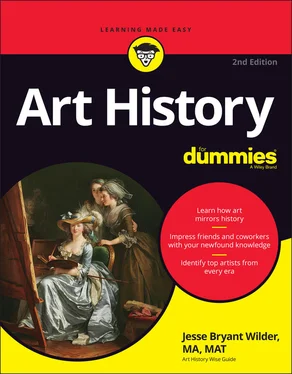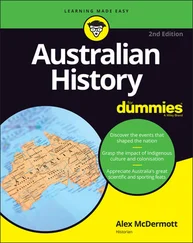Jesse Bryant Wilder - Art History For Dummies
Здесь есть возможность читать онлайн «Jesse Bryant Wilder - Art History For Dummies» — ознакомительный отрывок электронной книги совершенно бесплатно, а после прочтения отрывка купить полную версию. В некоторых случаях можно слушать аудио, скачать через торрент в формате fb2 и присутствует краткое содержание. Жанр: unrecognised, на английском языке. Описание произведения, (предисловие) а так же отзывы посетителей доступны на портале библиотеки ЛибКат.
- Название:Art History For Dummies
- Автор:
- Жанр:
- Год:неизвестен
- ISBN:нет данных
- Рейтинг книги:3 / 5. Голосов: 1
-
Избранное:Добавить в избранное
- Отзывы:
-
Ваша оценка:
- 60
- 1
- 2
- 3
- 4
- 5
Art History For Dummies: краткое содержание, описание и аннотация
Предлагаем к чтению аннотацию, описание, краткое содержание или предисловие (зависит от того, что написал сам автор книги «Art History For Dummies»). Если вы не нашли необходимую информацию о книге — напишите в комментариях, мы постараемся отыскать её.
Art History For Dummies
Art History For Dummies
Art History For Dummies
Art History For Dummies — читать онлайн ознакомительный отрывок
Ниже представлен текст книги, разбитый по страницам. Система сохранения места последней прочитанной страницы, позволяет с удобством читать онлайн бесплатно книгу «Art History For Dummies», без необходимости каждый раз заново искать на чём Вы остановились. Поставьте закладку, и сможете в любой момент перейти на страницу, на которой закончили чтение.
Интервал:
Закладка:
Where to Go from Here
You can dive into this book anywhere you like. I’ve organized Art History For Dummies so that you can read it in two ways:
You can take the full tour and read the book chronologically from cover to cover. This is a great way to see how art evolved over the millennia.
You can jump into any chapter or section within a chapter, extract the information you need, and skip the rest. For example, if you’re planning to see an Egyptian exhibition or you’re taking a test on the period, Chapter 6will give you all the information you need to ace the test or enjoy the show.
If you don’t begin at the beginning, I recommend starting with the chapter that covers the art you like best. If it’s Michelangelo and Leonardo, start with Chapter 11on the Early and High Renaissance; if it’s Frida Kahlo, start with Chapter 23, which includes Surrealism and other movements. Then fan out from there. Each period or movement will lead you to the periods that it grew out of and that grew out of it, giving you a better understanding of why Leonardo da Vinci, Michelangelo, or Frida Kahlo painted as they did.
Finally, if you have questions or comments about this book, you can e-mail me at jesse_bryant_wilder@hotmail.com .
Part 1
Getting Started with Art History
IN THIS PART …
Distinguishing between art history and history
Recognizing the effects of culture and society on art
Knowing why artists make art
Checking out the design elements
Identifying art periods and movements
Chapter 1
Art Tour through the Ages
IN THIS CHAPTER
 Understanding the difference between art history and plain, old history
Understanding the difference between art history and plain, old history
 Recognizing the importance of art from prehistoric times to the present
Recognizing the importance of art from prehistoric times to the present
 Seeing how art periods are linked to environment and culture
Seeing how art periods are linked to environment and culture
 Identifying the various art historical periods
Identifying the various art historical periods
 Noting the effects of modern pressures on art development
Noting the effects of modern pressures on art development
Why study art history rather than music history, literary history, or the history of the postage stamp? Art history, which begins around 30,000 BC with the earliest known cave paintings (see Chapter 4), predates writing by about 26,500 years! That makes art history even older than history, which begins with the birth of script around 3500 BC. Along with archaeology, art history is one of our primary windows into prehistory (everything before 3500 BC). Cave paintings, prehistoric sculpture, and architecture together paint a vivid — although incomplete — picture of Stone Age and Bronze Age life. Without art history, we would know a lot less about our early ancestors.
Okay, but what do you need art history for after people learned to write during the historical period, which kicks in around 3500 BC? History is the diary of the past — ancient and relatively recent peoples writing about themselves combined with our interpretations of what they say. Art history is the mirror of the past. It shows us who we were, instead of telling us, as history does. Just as home movies document a family’s history (what you wore when you were five, how you laughed, and what you got for your birthday), art history is the “home movie” of the entire human family through the ages.
History is the study of wars and conquests, mass migrations, and political and social experiments. Art history is a portrait of humankind’s inner life: people’s aspirations and inspirations, hopes and fears, spirituality, and sense of self throughout the ages.
Connecting Art Divisions and Culture
Art history is divided into periods and movements , both of which represent the artwork of a group of artists over a specific time period. The difference between a period and a movement has to do with duration (periods are typically longer than movements) and intention (movements have specific intent). See Chapter 3for more about art movements. An art period can last anywhere from 27,000 years to 50 years, depending on the rate of cultural change.
Here is a brief list, with examples of art periods and related cultural attributes:
Prehistoric art, the first leg of the longest art period, starts with the first known art around 30,000 BC, give or take a few thousand years, and lasts until the end of the Paleolithic period, or Old Stone Age, around 10,000 BC. The exact duration depended on where the artists lived with respect to the receding Ice Age. In those days, culture changed about as fast as a glacier melts — and this was long before global warming.
Prehistoric art, the next leg of the first period, the Neolithic or New Stone Age, lasted roughly another 6,500 years, from 10,000 to 3,500 BC, again depending upon where people lived. In the first period, people used stone tools, survived by hunting and gathering (in the Old Stone Age) or agriculture (in the New Stone Age), and didn’t know how to write — these are the period’s defining cultural characteristics.Painting hit rock bottom during the New Stone Age (the Neolithic Age), despite the fact that they had better stone tools, herds of domesticated animals, and permanent year-round settlements. But architecture really got off the ground with massive tombs like Stonehenge, temples, and the first towns. Although they couldn’t write, Old and New Stone Agers sure could express themselves with paint and sculpture. In the Old Stone Age, artists painted pictures of animals on cave walls and sculpted animal and human forms in stone. It seems their art was part of a magical or shamanistic ritual — an early form of visualization — to help them hunt.
The Neoclassical art period, by contrast, only lasted about 65 years, from 1765 to 1830. The pressures from the Industrial Revolution accelerated the rate of social and cultural change after the mid-18th century.
It’s Ancient History, So Why Dig It Up?
Ancient art teaches us about past religions (which still affect our modern religions) and the horrors of ancient warcraft. Rameses II’s monument celebrating his battle against the Hittites (see Chapter 6) and Trajan’s Column (see Chapter 8), which depicts the Emperor Trajan’s conquest of Dacia (modern-day Romania), are enduring eyewitness accounts of ancient battles that shaped nations and determined the languages we speak today.
Art isn’t just limited to paintings and sculptures. Architecture, another form of art, reveals the way men and women responded to and survived in their environment, as well as how they defined and defended themselves. Did they build impregnable walls around their cities? Did they raise monuments to their own egos like many Egyptian pharaohs (see Chapter 6)? Did they erect temples to honor their gods or celebrate the glory of their civilizations like the Greeks (see Chapter 7)? Or did they show off their power through awe-inspiring architecture to intimidate their enemies like the Romans (see Chapter 8)?
Mesopotamian period (3500 BC–500 BC) and Egyptian period (3100 BC–332 BC)
Интервал:
Закладка:
Похожие книги на «Art History For Dummies»
Представляем Вашему вниманию похожие книги на «Art History For Dummies» списком для выбора. Мы отобрали схожую по названию и смыслу литературу в надежде предоставить читателям больше вариантов отыскать новые, интересные, ещё непрочитанные произведения.
Обсуждение, отзывы о книге «Art History For Dummies» и просто собственные мнения читателей. Оставьте ваши комментарии, напишите, что Вы думаете о произведении, его смысле или главных героях. Укажите что конкретно понравилось, а что нет, и почему Вы так считаете.












